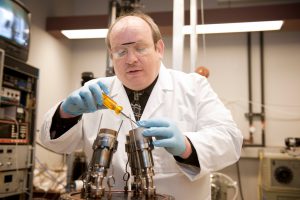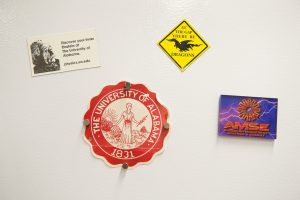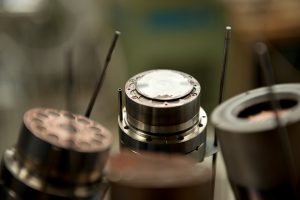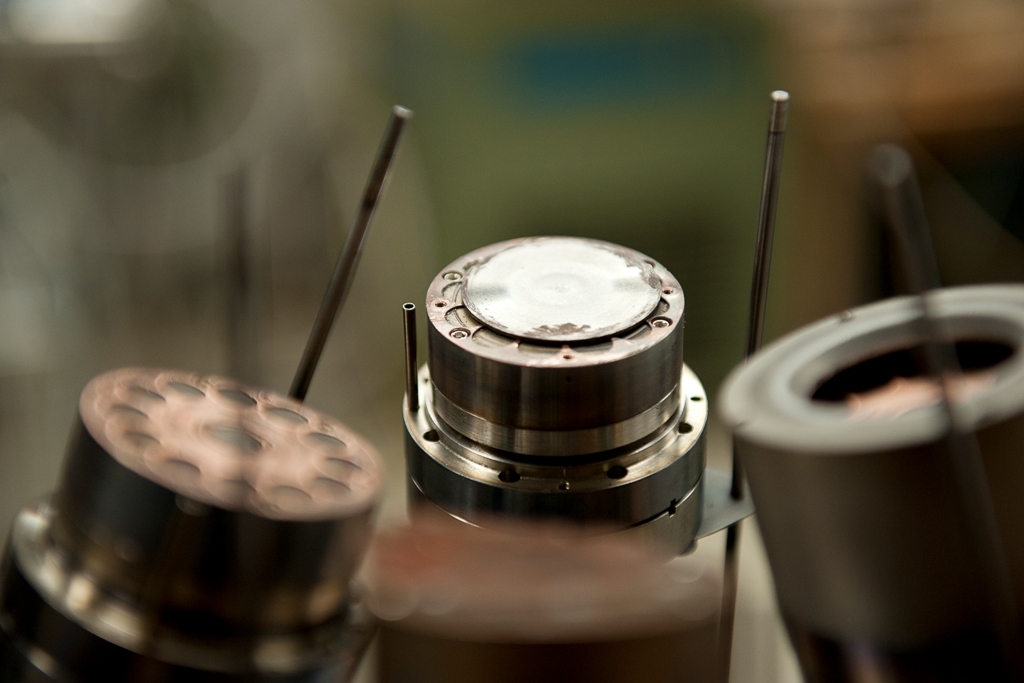By Chris Bryant and Janice Fink
Photos by Samantha Hernandez
Most people know all about refrigerator magnets. But magnetic refrigerators? Not so much.

According to Dr. Gary Mankey, a professor of physics at The University of Alabama who researches thin-film materials, a magnetic refrigerator operating at room temperature would use a third as much electricity as a typical home refrigerator.
Since refrigerated devices, including air conditioners, account for a large percentage of the electricity consumed in a home, switching to magnetic cooling could substantially cut a power bill.
Sounds wonderful, right? Well, don’t head, just yet, to your favorite home appliance store to ask which aisle is stocked with magnetic refrigerators.
“The challenge,” Mankey says, “are the problems with the known materials that make magnetic refrigeration possible. The materials must be tuned to exhibit the desired effect in a narrow range near the desired cooling temperature.”
Such refrigeration relies, Mankey says, on materials known as magnetocalorics. More on what makes those materials work later. But, the ones which have been tested, Mankey says, are either toxic, expensive, rare or all of the above.
Toxic materials within your refrigerator? That can’t be pretty.
So, Mankey’s research group is experimenting with better alloys that meet the basic requirements. The ideal material, he says, would be inexpensive, nontoxic, easy to produce in bulk and able to provide cooling with a modest magnetic field of 1 to 2 tesla. (A loudspeaker magnet is about 1 tesla; a refrigerator magnet is about 5 milli-tesla.)
Mankey fabricates the candidate materials at UA’s MINT Center and measures them at the Spallation Neutron Source in Oak Ridge National Laboratory. He and his research group think that by using neutron-scattering techniques at Oak Ridge they can acquire the information needed for smart design of a magnetocaloric thin film to enable magnetic refrigeration, instead of using alloys containing exotic materials.

“We’re exploring alloys of iron, manganese, bismuth, aluminum and others,” Mankey says. Pilot studies that measured magnetic properties of iron-rhodium-palladium thin films are being followed up with studies that replace the expensive rhodium-palladium compound with bismuth-aluminum compounds.
Magnetocaloric materials heat up, Mankey says, when placed in a magnetic field and rapidly cool below their original temperature when withdrawn from the field.
He explains why.
“The magnetic field causes the magnetic domains in the material to align, releasing thermal energy within the material,” he says. “When the field is withdrawn, the extra thermal energy is released when the domains lose their magnetic orientation. They rapidly absorb energy when they reorient themselves, and, as they do so, the temperature of the material drops.”

Scientists have been familiar with magnetocaloric materials for years, but magnetic refrigeration requires that they operate near room temperature, the UA College of Arts and Sciences researcher says.
In 1997, the first near-room-temperature, proof-of-concept, magnetic refrigerant was demonstrated at the Department of Energy’s Ames Laboratory, which used commercial-grade gadolinium alloys rather than more expensive research-grade alloys, Mankey says. As a result, scientists and companies worldwide started developing new types of room-temperature materials and magnetic refrigerant designs.
Gadolinium, however, is found in only a handful of locations on the planet and is only accessible via deep mining, so even commercial-grade gadolinium is too costly to be viable. And while manganese arsenic alloys can achieve a similar affect, arsenic, in its elemental form, is poisonous. So, the search continues.
Versions of this technology are already being used for some research processes that require very low temperatures. But their applicability to consumer products has lagged behind due to the difficulties with materials, barriers that may be broken by outcomes of current studies and funding for future research.
“We’ve encountered some interesting leads,” Mankey says. “The science is challenging, and it requires a fundamental understanding of magnetism. We are attacking this problem by applying the same smart-design methods that are used in developing materials for magnetic recording that enable faster, cheaper and higher capacity hard drives for computers.”
Contact
Bill Gerdes, UA Media Relations, 205/348-8318, bgerdes@cba.ua.edu
